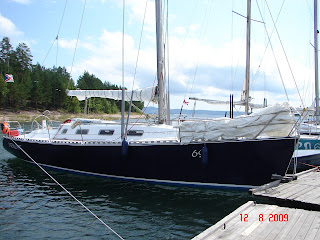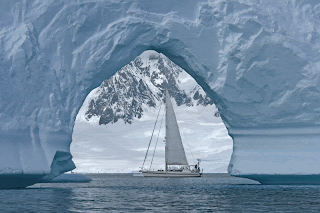Today I received an email from Magnus Murphy to tell me that he has started a
Shearwater Yacht Owners Group on FaceBook for owners of boats to our Shearwater 39 & 45 designs, as well as anyone else who has an interest in these boats. Magnus and his family own a really nice and rather well-known Shearwater 39 named "Losloper" (Afrikaans for Wanderer), pictured below. She was built in Cape Town by perfectionist craftsman Gary Back as his personal boat, was refitted after being damaged in a hurricane in the Caribbean, then was bought by Bernadette and Douglas Bernan. For a few years they cruised on her as "Ithaka", recording their adventures in Cruising World magazine, where Bernadette had been employed as Editor.

The Shearwater 39 design was commissioned by Gerfried Nebe, of Nebe Boatbuilders, who wanted a seaworthy and fast cruiser with modern underbody and classic good looks. The result was a very pretty and extremely capable offshore yacht that turns heads wherever it goes. Marketed only in the small South African market and mostly during the era of political isolation, it nevertheless gained a good following. I have lost track of many of the boats but here are some bits of info that I hope will not bore you to tears.
Hull #1 was built from wood and was Gerfried Nebe's own boat "Gabriel". The moulds for the GRP boats were taken from her. Gerfried has cruised her extensively in the Atlantic and is now readying her for her next voyage.
Hull #2 was built from aluminium by Jacobs Brothers Boatbuilders in Cape Town, for Lofty Huysamer. Lofty was a perfectionist but his own workmanship did not meet his own high standards. He fitted out the boat himself and kept rejecting his own work and ripping it out. When he left Cape Town his boat was little more than an empty shell, with only a nav station, galley and platform for a berth. She is now named "Skylark II" and is owned by Chris & Desiree Tattles of New Zealand. (Updated March 2012)
Hull #3 was built by John & Jo Fensham. She was launched as "Tamborine" and was sold about 2002. John says that she has left South Africa but he does not know where she is now. (Updated Jan 2012).
Hull # 4 belonged to an Italian family and was named "Kalahari", pictured below. She was lost in a small port in Croatia or thereabouts, when every boat in the harbour was shelled and sunk. Being a war situation, her owners received no insurance payout.
Hull #5 is a gaff-rigged excursion schooner built by Roddy Johnston. She carried passengers in Hout Bay, South Africa, for a seaon or two. He then moved her to the Caribbean, where she has carried thousands of excursion passengers as "Spirit of Anegada". She was owned/operated for a few years by Nick & Lyndsay Voorhoeve, who later commissioned our successful little Cape Cutter 19 design that is now built in UK.
Hull #6 - was fitted out by Brian Bax and launched as "Erica-Joe".
Hull #7 became "Shoestring III", owned by my good friends Petr Muzik & May Lyon. Petr has circum-navigated on her, completing his voyage in December 2007 at the age of 69. She is now based in Port Owen on the SA West Coast. Here is "Shoestring III" on her launch day.
Hull #8 was owned and fitted out by Richard Acheson, who later started Shearwater Yachts to build the Shearwater 45. His 39 was named "Askari". He sold her ro Richard Brown, of Portland, Oregon. (Update March 2012).
Hull #9 was built by John & Hilary Price and named "Talitha Koum". She now belongs to Gordon Joyce and is based in the Persian Gulf, named "Talitha". (Updated March 2012)
Hull #10 is named "Pinta". She has a custom traditional two-box deck and gaff schooner rig and is owned by Robin and Laetitia Ellis. She is based in Port Owen on the West Coast of South Africa.
Hull #11 belonged to Thys Henson. On delivery to her new owner, Gordon Joyce, in the Persian Gulf in January 2008, she became entangled in fishing nets at night. Her delivery crew scuttled her in very unfortunate circumstances soon after, so that they could be removed from her by a passing ship. This episode resulted in the delivery skipper losing his RYA certification. She was named "Pamelou". Gordon Joyce bought #9 to replace her.
Hull #12 was bought by Juri Terblanche then sold to Ken Nicoll before Juri had progressed much with the fitout. John Fensham (owner of #3) fitted her out for Ken. The Nicoll family sailed her for a few years before a declining economy forced them to sell. Her next owner was Willie Vanderverre, who once told me that she was the most seaworthy boat he had ever owned, which included much bigger boats. Her next owner was Walter Burgoyne, who sold her to her current owner, Dennis Jud. She has been renamed "Centime" and is cruising the world. (Added March 2012)
Hull #13 was Gary Back's boat "Slithermoon". She was bought by Douglas and Bernadette Bernon and renamed "Ithaka". She is now magnus Murphy's "Losloper".
Hull #14 was launched as "Helen Mary" by Bill Howard. She is now named "Cathexis".
Hull #15 is "Freyja", originally owned by Koos Steyn and now Michael in Tasmania.
Hull #16 - Still owned by her original owner, Richard walker, and based in Fort Pierce, Florida. Her name is "Luric". (Updated August 2014)
Hull #17 was built by Nebe Boatbuilders for Lewis Gerber and named "Honeychile". She now belongs to champion South African canoist Robbie Herreveld.
Hull #18 - "Enhantica", owned by Chris Ellis and in France as of July 2014.
Hull #19 - Owned by Alan Ward and based in Port Owen on the South African West Coast, she is named "Windward".
Hull #20 - This boat was originally commissioned by a Mr Wessels. By a process of elimination, this seems to be the boat launched by Peter van Andel in Mossel Bay as "Take Five". Her next owner renamed her "Amajuba". She is now owned by Jaques Gregory and is named "Navigator". (Updated August 2014)
Hull #21 is based in Kiel, Germany, owned by Dr Reinhard Wiegers.
Hull #22 - Wooden boat being built by Richard Styles in Australia, status unknown.
Hull #23 belonged to Mark Sweet, who was fitting her out with custom deck and gaff schooner rig for excursion work in Knysna, on the South African South Coast. One cold winter night a group of bergies (vagrants) climbed over the fence to shelter under her from the rain. Their fire got out of control and Mark's boat went up in flames.
Hull #24 was launched a couple of years ago by Rod & Mary Turner-Smith. Named "Sheer Tenacity", they are cruising in distant waters.
Hull #25 is named "Sea Lion" and is owned by Englishman Chris Hull. She is currently in the Caribbean (Updated March 2012)
I have lost track of those that are shown as "Unidentified". Hulls sometimes changed hands during fitting out, so their histories are not easy to follow. I hope to fill in more of the blanks as info comes my way
Another boat that is not on my list is "Ukelele Lady", built for and owned for years by my good friend Nick Taylor. I sailed on her in the 1993 Cape to Rio Race as navigator and sailing master. Although we are still good friends, Nick swears that he will never sail long distance with me again because I am a madman on a boat. In explanation, I should tell you that I like to sail fast and efficiently. Nick likes to cruise and to do so slowly when he cannot see where he is going, such as any time that the sun goes to sleep. This normally happens about 12 hours out of 24, so Nick was very unhappy with my need to sail very fast 50% of the time that we were on the ocean. He named me "Herr Doktor" because he felt that I had been expelled from the Gestapo for cruilty. Like I said, we are still good friends.
A few other 39s are also being built from wood or aluminium in other parts of the world.
The Shearwater is one of my favourite designs. I don't think that there is anything in it that I would change if I were to draw her again. It is one of those most wonderful of boats that sails much faster than it looks like it should. It is bad to design anything that looks fast but isn't, whether a boat, car, airplane or whatever. In contrast, it is great fun to pass anyone who believed their car/boat/airplane/whatever to be faster. The Shearwaters do that with style.
I will leave the Shearwater 45 for another time.
Link to
Shearwater 39 web page.
:-) _/) _/) _/) (happy sailing smiley)
Dudley Dix












.JPG)












